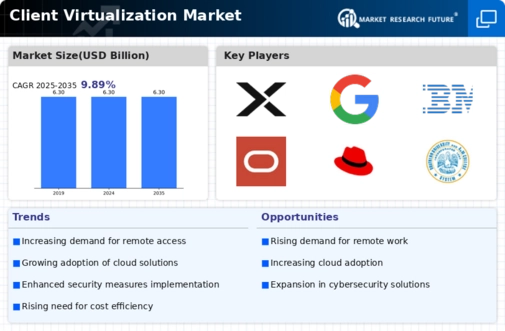Top Industry Leaders in the Client Virtualization Market
Latest Company Updates:
April 2023-
Virtual Desktop, widely known for being a VR application that lets users stream PC VR games to their VR headsets, has recently released a major update that introduces a new feature called "Super Resolution." This feature takes advantage of Snapdragon Game Super Resolution (SGSR) support, a technology specifically optimized for Qualcomm's Snapdragon mobile chips that are commonly used in VR headsets. The update allows Virtual Desktop to upscale and enhance the resolution of VR visuals streamed from a PC beyond the native resolution of the VR headset. Overall, the update introduces SGSR upscaling to improve visual quality in Virtual Desktop's existing wireless PC VR streaming feature.
Some of Client Virtualization Companies Listed Below:
- Cisco Systems Inc. (US)
- VMware (US)
- Oracle Corporation (US)
- Citrix Systems Inc. (US)
- Parallels International GmbH (US)
- Microsoft Corporation (US)
- Nutanix (US)
- NComputing Co. Ltd. (South Korea)
- Ericom Software (US)
- Toshiba Corporation (Japan)
- IBM Corporation (US)
- Amazon Web Services Inc. (US)
- HP Inc. (US)
- Evolve IP, LLC (USD)
- Huawei Technologies Co. Ltd (China)
Strategies Adopted:
- Innovation: Continuous development of new features and functionalities, integration with emerging technologies like AI and machine learning, and focus on security and compliance.
- Subscription Models: Transitioning from perpetual licensing to subscription-based models for recurring revenue and faster product updates.
- Partnerships and Acquisitions: Collaborations with hardware vendors, cloud providers, and software developers to expand reach and service offerings.
- Vertical Specialization: Tailoring solutions to specific industry needs, such as healthcare, finance, or education.
Market Share Analysis Factors:
- Product Features and Functionality: Breadth and depth of features, ease of use, performance, and security are key differentiators.
- Pricing and Licensing Models: Competitive pricing, flexible licensing options, and support for different deployment models (on-premise, cloud, hybrid) are crucial.
- Brand Reputation and Customer Support: Established brands and reliable customer support inspire trust and loyalty.
- Technology Partnerships and Integrations: Compatibility with existing IT infrastructure and integration with complementary technologies are vital.
New and Emerging Companies:
- Cloud-native platforms: WorkOS, Paperspace, Vectordash
- Security-focused solutions: Bromium, Hypervisor One
- Remote desktop solutions: AnyDesk, Splashtop
These new entrants bring innovative approaches to specific market segments, offering potential disruption to established players.
Current Investment Trends:
- Cloud-based virtualization: Increasing adoption is driving investments in cloud-based solutions, infrastructure, and security.
- Security and compliance: Growing cybersecurity threats and stricter regulations are fueling investments in security features and compliance certifications.
- End-user experience: Focus on simplifying user interfaces and enhancing performance is leading to investments in user-friendly features and optimization techniques.
- Emerging technologies: Integration of AI, machine learning, and containerization technologies is attracting investment for automation, performance optimization, and application management.









